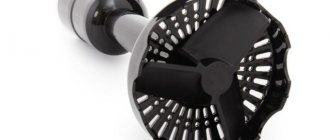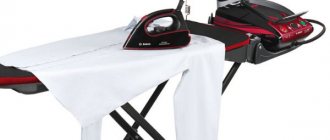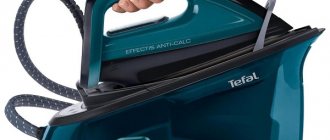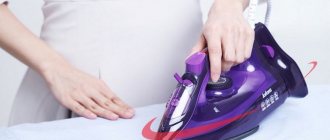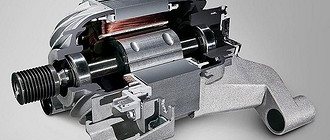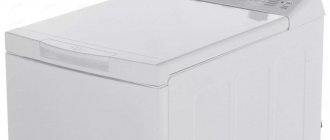Among the variety of household appliances, it is sometimes difficult to determine how the devices differ from each other.
There are several devices that generate steam, but at the same time perform different functions.
The question often arises about what is better: a steamer or a steam generator. There is no definite answer - both devices have their pros and cons.
In some conditions, priority is given to steam generators, and in others, to the steamer. When and how best to use a particular device should be analyzed comprehensively.
Page navigation:
Steam generator
The steam generator is designed to replace a conventional iron, but with a much more powerful steam supply.
Its design is very similar to a classic iron. The main difference from conventional technology is the volume and speed of steam supply. Water is supplied to the boiler from a separate container. Then it is heated to the state of steam, which is supplied to the iron through a hose. This is the standard method of steam supply used in most steam generators. But in LAURASTAR steam generators, engineers have improved the operating principle: the steam flow is heated a second time in the soleplate of the iron, due to which it does not leave wet marks on clothes and increases in volume several times compared to other similar devices. The steam is finally heated to 160°C. Compared to steam from a conventional iron, the stream from the generator penetrates fabric fibers more effectively, making it excellent at smoothing even thick fabrics and bedding in several layers. The steam supply speed is on average 100 g/min. Steam generators can be additionally equipped with a steam boost function. The same option is available for irons. However, in steam generators the steam supply rate upon impact is much higher - about 300 g/min. This flow quickly and effectively smoothes multi-layered, thick clothes or linen. An additional advantage of steam in LAURASTAR steam generators is that it also has disinfecting properties. It eliminates 99.999% of bacteria and allergens and 100% of dust mites on clothing, making it an excellent solution for caring for baby clothes, clothes for allergy sufferers, bedding, etc.
The steam flow from the generator does not spoil the color of the fabric. It also allows you to freshen your clothes by getting rid of excess odor. Items that are not allowed to be washed or have not yet been decanted are refreshed with a steam generator using vertical steaming. The presence of this function in the device must be provided by the manufacturer.
Steam generators are often used for delicate textiles and fabrics with embroidery or appliqué. They can be used horizontally on an ironing board or vertically, like steamers. Heating and preparing steam takes from 2 minutes. The design of the device is thought out so that the device does not feel heavy in the hand. The water tank and heating elements are placed in a separate block. This ergonomic distribution of functional elements allows ironing without much effort.
Advantages of the steam generator:
- completely replaces a simple iron;
- smoothes even dense fabrics;
- processes multi-layered items;
- disinfects tissues;
- supplies a large volume of steam and has a “steam boost” function;
- ergonomic, lightweight design.
Features of LAURASTAR steam generators from Switzerland:
- supply of “dry” steam;
- attachment for delicate fabrics included in all models;
- vertical steam function;
- When used correctly, there are no wet streaks left on the fabric: before ironing, you need to release the steam for 10 seconds.
What to choose
When choosing between these two devices, be guided by personal preferences. A steam generator is a steam iron. To use it, you need an ironing board or any other hard surface to thoroughly iron the fabric. At the same time, it copes well with bruises and has many uses. In turn, a steamer is a fundamentally new type of equipment, designed specifically for domestic use. It also has many functions and takes much better care of your clothes than a regular iron.
It is worth noting that both devices have many good reviews and will be a godsend for those who do not like to iron clothes.
Steamer
The main task of the steamer is contactless vertical smoothing of fabric with steam.
There is no physical contact or pressure on the material. The volume of steam during heating is less than when the steam generator is operating, and the steam pressure is also lower. But usually steamers supply wet steam, which causes some discomfort when smoothing things. This is especially true for plain and delicate fabrics: wet marks will ruin the appearance of the clothes. However, LAURASTAR has developed an exclusive dry steam technology. The steam in the IGGI steamer is heated twice, due to which there is practically no moisture left in it at the exit. Dry steam increases in volume several times and penetrates deeply into the fibers at a speed of 20–30 m/sec. The steam pressure at the outlet nominally reaches 3.9 bar. This is more than even some steam generators.
The steam temperature leaving the IGGI steamer is approximately 100°C. The Swiss laboratory Scitec Research SA has found that LAURASTAR steam kills 99.9% of viruses, bacteria and 100% of dust mites that remain in the fibers even after washing. The steamer copes perfectly with the tasks of thermal treatment of clothes and linen.
If you are considering purchasing a regular steamer without a dry steam function, you need to understand that wet steam contains large suspended particles of water. Therefore, they will not be able to process thick fabrics and multi-layered clothing. After treatment with wet steam, things need to dry.
Two types of steamers are used:
- Manual. The design consists of a handle, a water tank and a heater. The weight of the device mainly falls on the handle, but it is still quite mobile and easy to use. It is easy for them to iron hanging curtains and clean upholstered furniture.
- Vertical. It is a trempel with a separate tank for heating water, a steam line and a nozzle for steam release. The volume of the water tank is about 1 liter. The radius of movement is limited by the steam pipeline; on average, its length is 1 meter.
To work with the steamer you do not need an ironing board - it is a vertical design. It doesn’t take much time to prepare for work: steam is ready to be supplied within a minute after turning on the device or even less. But ironing takes longer than when using a steam generator, especially if the item is multi-layered. Each layer will have to be processed separately.
Typically, handheld steamers supply wet steam. But LAURASTAR manual steamers, like steam generators, heat the flow twice and supply “dry” steam. This option will be especially useful if you need to refresh and disinfect items that cannot be washed: helmets, jackets, pillows, soft toys, etc.
Advantages of the steamer:
- quick preparation for ironing;
- vertical processing of things;
- can be used for thin and delicate materials;
- does not deform the fabric;
- effective when processing clothes with decorative inserts;/li>
- compact dimensions: for example, the IGGI steamer fits into hand luggage.
Disadvantages of the steamer:
- not suitable for processing thick fabric;
- long ironing process;
- short working time.
How does a clothes steamer work and how does it differ from a steam generator?
The technology for smoothing out wrinkles under the influence of a jet of heated steam remains the same, but the design of the device has changed.
Operating principle of a household laundry steamer
A steamer is a device for steaming and disinfecting clothes with wet steam in a vertical position. The principle of operation is the same as that of a steam generator, but here steam is supplied by gravity through built-in nozzles without pressure.
Types of steamers for clothes made from exclusive fabrics
A handheld steamer is similar to a travel hair dryer. It fits easily in a bag. It is convenient for them to iron 2-3 items from a suitcase at a time.
In a pinch, it can replace the kettle to boil a small amount of water (just kidding).
A vertical (floor) steamer consists of a large boiler, a vertical stand and an iron with a long hose.
Such a device can have up to 8 operating modes, a boiler with a capacity of up to 4 liters of water. Expensive models have dual heaters, an automatic shut-off system, and several additional attachments and accessories.
The shape of a ceramic or plastic iron can be oval or trapezoidal.
The operation of such a steamer from Philips is shown in its video.
Device comparison
A steamer is suitable if you need to quickly refresh your clothes before going out.
The steam generator is suitable for large-scale ironing. The steam in the steamer has a temperature of no more than 100°C, in the steam generator - up to 180°C.
The steamer gets ready for use in about 1-2 minutes. With a steam generator it takes 2-3 minutes. Models with a large tank will have to wait up to 10 minutes. LAURASTAR equipment heats up in 2-2.5 minutes.
The steam supply volume when the steamer is operating is 25-60 ml/min, the steam generator is 80-150 ml/min.
With a steamer, processing is done without contact; with a steam generator, you can iron the item horizontally on a board and steam it vertically.
The first device does not have an iron with a soleplate, while the second one is an important functional element - steam is supplied through it.
The steamer works vertically, the steam generator - vertically and horizontally, for which you will need to use an ironing board.
Life example “on fingers”
Of course, it is acceptable to walk around ironing curtains with a steam generator in your hands, but the device is simply not designed to perform such operations. To demonstrate, let’s imagine how an iron with a steam generator or a steamer worked in this situation:
- A mobile “vacuum cleaner” can be easily brought to the place where the curtains hang. You just need to start the steamer, move the brush from side to side - the job is done. There is no need to remove the product from the eaves; on the contrary, it will look better in a canopy.
- Now let's imagine: there is no steamer. We will place the heavy steam generator on a fairly high table, trying to be sure to reach every corner of the curtain. Only if the product is completely clean! Otherwise, the algorithm looks more complicated. You will need to wash the curtains first, then iron them. The ironing board is not suitable for large fabric sizes. Giant curtains cannot be ironed at all. Therefore, the product is hung back, and a long tedious walk around the square begins with an “iron” in hand and a table standing nearby.
The second example concerns a pleated skirt. A steamer can create creases, but at what cost? Difficult process. How is a steamer different from a steam generator? Constantly hovers in the air above the thing. Take it and try to secure the clothes properly for ironing and not get burned by the steam.
The steam generator is another matter. Carefully go through fold after fold in a natural manner; if necessary, use steam to enhance the effect. Success is secured with a hot sole pressing down on the surface. A steam generator, a steamer are different things, the examples given fully reveal the aspect.
Which device is better?
Devices have their own tasks and features, which determine their use.
The steamer is more convenient when:
- the need to quickly refresh wardrobe items;
- disinfection of outerwear, soft toys, hard surfaces, curtains, furniture.
A steam generator is best when you need:
- ironing thick and rough fabrics;
- ironing multi-layered clothes or linen;
- disinfectant ironing, especially if there are small children;
- high ironing speed;
- large amount of ironing.
Before choosing a device for your home, get to know all the pros and cons. Also think about the tasks that need to be solved using the device.
Common features
It’s easy to guess that the operating principle of all devices is based on the supply of steam. This is true. Steam is used in all appliances for a number of reasons:
- The steam has a temperature of about 130°, so it easily destroys most microorganisms, moth larvae, mites and mold that collect in the weaves of fabric threads and folds.
- The steam flow also helps in removing stains - it moistens the dust and softens the dirt, after which it is effectively removed with a brush. An additional advantage is that there is no need to use chemicals that are harmful to health.
- It also removes unpleasant odors, which is especially important for pet owners.
Otherwise, the operating principle and, accordingly, the use of steamers, steam cleaners and steam generators still differ, so it is best to focus on each device separately.
Drawing conclusions
If your wardrobe contains a lot of clothes made from delicate fabrics with a complex cut that take a long time and are difficult to iron, you should opt for a steamer.
Manual or vertical. It will save your time and effort. A steam generator is good if there are children in the family, people with allergies, or in general a large volume of clothes that need to be ironed regularly. LAURASTAR equipment is a leader in the category of steam generators and steamers. In addition to their high power and smart design, the Lift, Lift Plus and IGGI models also disinfect fabrics, eliminating 99.999% of bacteria and allergens.

